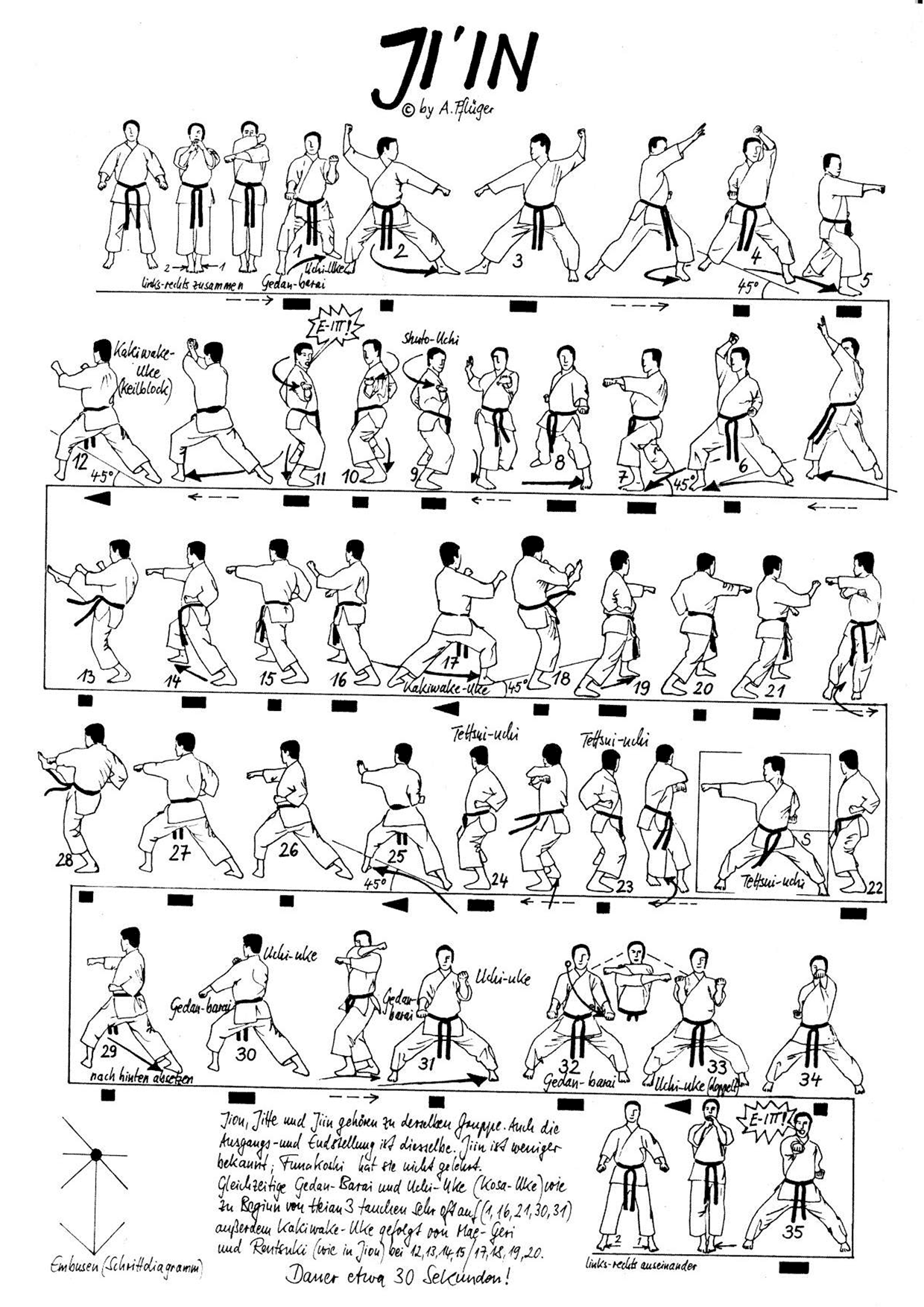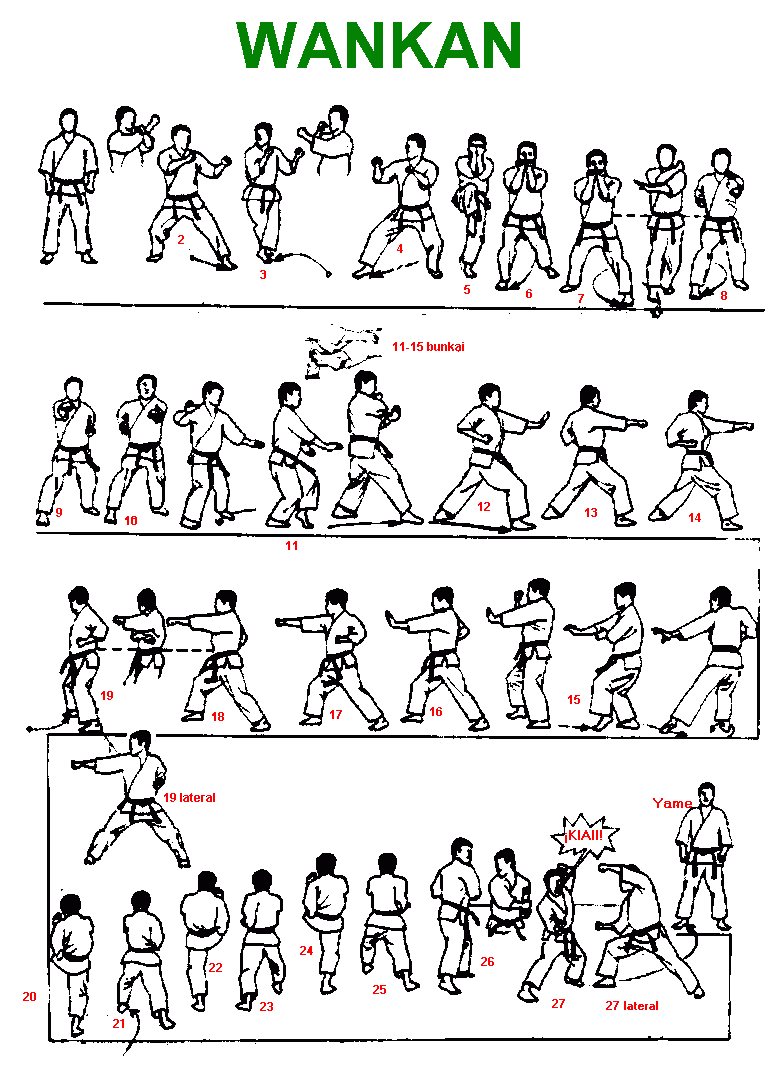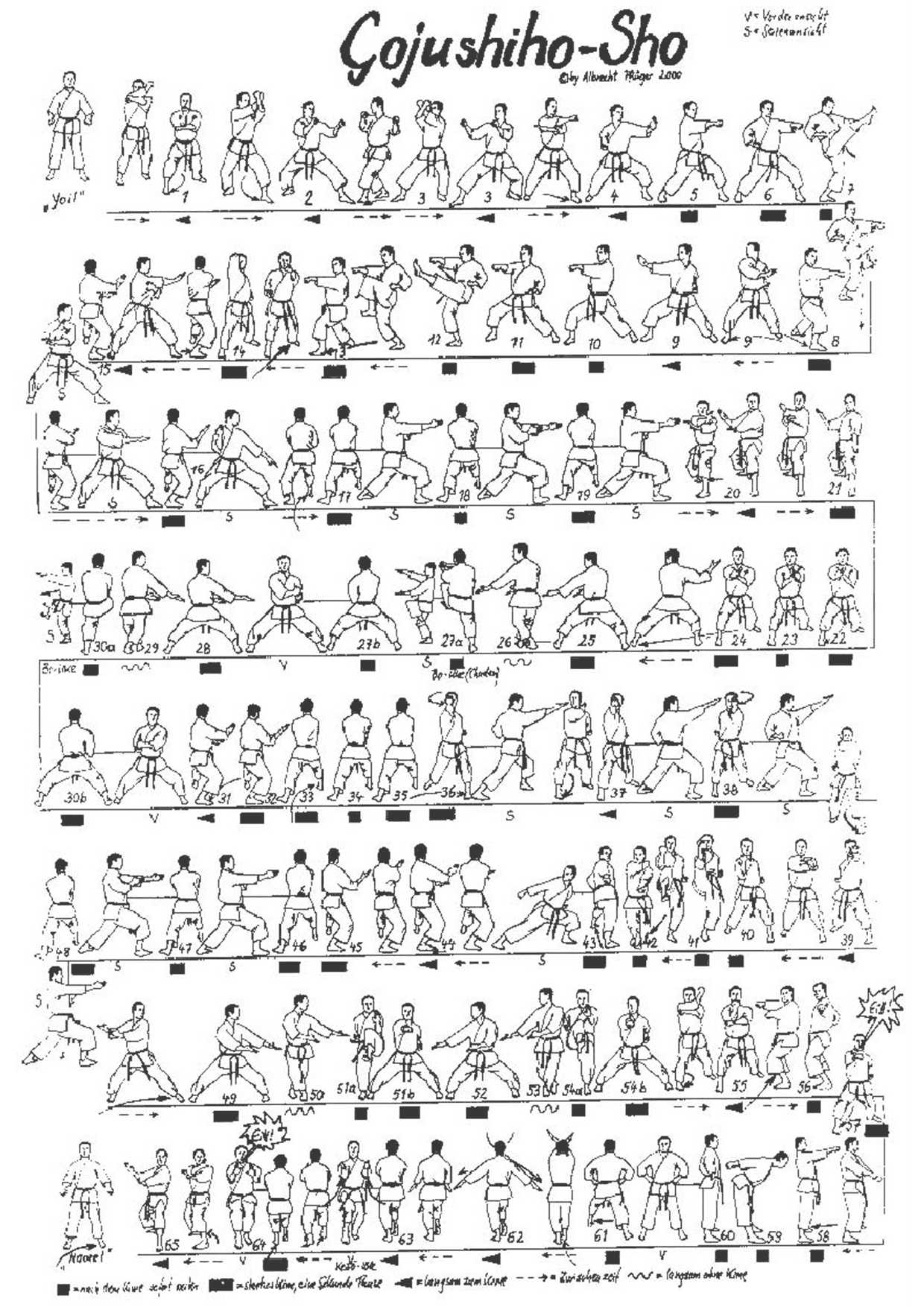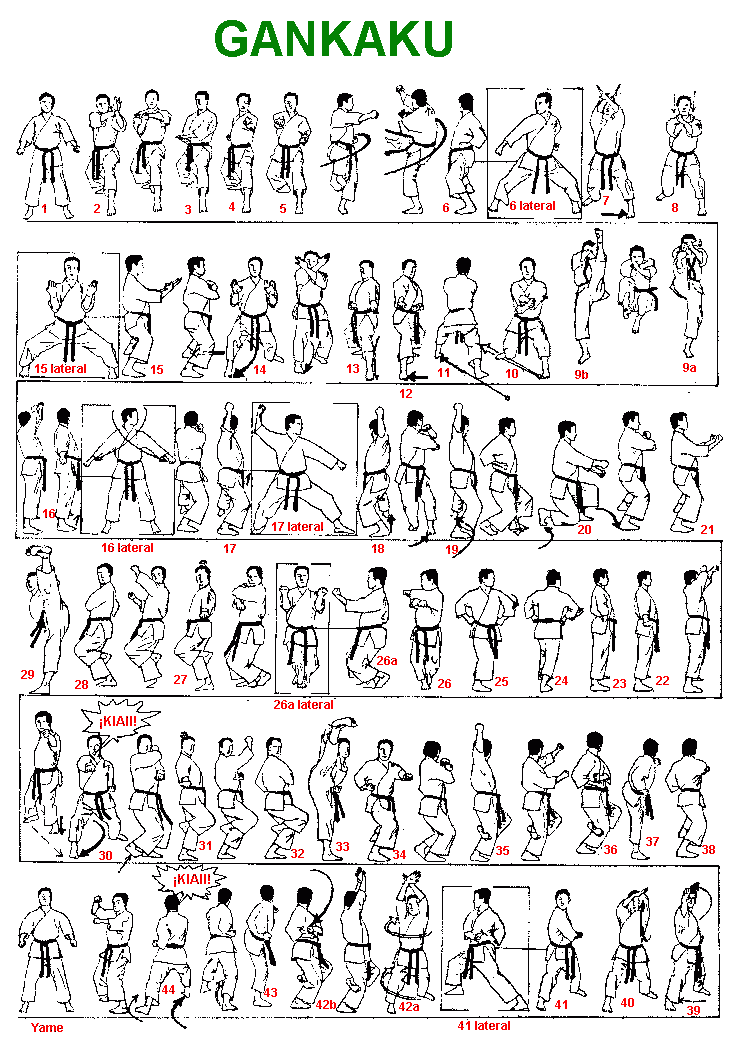
Kata
-
Sequence of moves
-
Pattern, form, routine, or method
-
Way of doing something
-
Training drill
All of the definitions of kata essentially refer to the same basic concept — a form, routine, or pattern of behavior that can be practiced to develop a skill to the point where it becomes second nature.
Practicing kata (patterns) consistently and deliberately forms a habit. Forming a habit develops new skills. With new skills comes increased confidence in one's abilities to recognize and make small improvements that keep a person (or a process) in top form continuously.
Shotokan Kata List
00
10th kyu - 9th kyu
White Belt - Orange Belt
Kihon Kata is the first most basic of all Shotokan karate kata series.
There are 20 Counts in Kihon Kata wherein counts
1, 3, 5, 9, 11, 13, 17, and 19 are the blocking techniques, and the rest of the techniques being a lunge punch. Front stance is used throughout the kata.
01
9th kyu - 8th kyu
Orange Belt - Red Belt
平安初段 (peaceful mind)
Originally the second of the five kata, this is now practiced as the first by most novice students in modern Shotokan Karate clubs. Heian Shodan is distinguished by its use of the down block, the upper block, the middle level stepping punch, the sword hand block, and the fact that every technique takes one step to complete.
02
8th kyu - 7th kyu
Red Belt - Yellow Belt
平安弐段
Heian Nidan may be easy to break down into its essential content, but within it can be found some very effective techniques and maneuvers. The opening movements are interesting joint attacks aimed at the opponent's elbows. The spear hand technique demonstrates the use of simultaneous blocking and attacking. The side snap kick and back fist performed early in the kata are other examples of the tactic. The kata also includes reverse side blocking techniques in its second half.
03
7th kyu - 6th kyu
Yellow Belt - Green Belt
平安参段
Heian Sandan is known for its use of horse riding stance, stamping kick, spinning techniques and block/strike combinations. Heian Sandan training is designed to impart an understanding of complicated turning and footwork as well as close distance
fighting techniques
04
6th kyu - 5th kyu
Green Belt - Purple Belt
平安四段
Heian Yondan has 27 moves and the embusen is almost I-shaped. This kata has many similarities to Heian Nidan. Tha kata's primary stance is back stance. New techniques to students are kosa-uke, shuto-uchi, kakiwake-uke, mae-empi and hiza geri.
05
5th kyu - 4th kyu
Purple Belt - Purple/White Stripe Belt
平安五段
Heian Godan is the last kata in the Heian series and has 23 movements. The embuse is almost T-shaped. The combination of quick and slow movements, timing skill and fluidity of motion are essential for this kata. It is the first Shotokan kata containing a jump (tobi-komi). Mikazuki geri, shuto uchi/manji uke combination are vital for proper kata performance.
06
4th Kyu - 3rd Kyu
Purple/White Stripe Belt - Brown Belt
鉄騎初段
Tekki Shodan (iron horse) is the first kata in the Tekki series. Having 29 counts, it is performed almost entirely in a horse stance. The embusen is a straight line and footwork is accomplished in a sideways manner using the crossing step. New techniques learned in this kata include kagi zuki, namae ashi, haiwan-nagashi uke/tate uraken combination.
07
3rd kyu - 1st dan
Brown Belt - Black Belt
抜塞大
Bassai Dai (Penetrate the Fortress - Big) exhibits the power and spirit required to break through an enemy's castle. It is characterised by many switching arm blocking combination, making effective use of the hanmi/gyaku-hanmi positions. It has 42 movements and many techniques are seen for the first time such as tate shuto uke, sukui uke and yama zuki.
08
3rd kyu - 1st dan
Brown Belt - Black Belt
燕飛
Enpi (Flying Swallow) has 37 counts and is a very dynamic kata. Empi is characterised by quick changes in direction, as well as many sinking and rising motions that mimic the swallow's flight. Empi offers several new techniques such as age zuki, kaiten tobi (spinning jump) etc.
09
3rd kyu - 1st dan
Brown Belt - Black Belt
慈恩
Jion (Love and Goodness) is comprised mostly of pieces from Heian and Tekki Kata. It has 47 counts and contains some of the most basic movements that Shotokan has to offer, it is an excellent kata to judge one's overall technique. Each technique should be performed with explosive power and unwavering stability.
10
3rd kyu - 1st dan
Brown Belt - Black Belt
観空大
Kanku Dai (Viewing the Sky- Big) is the longest kata having 65 movements. This kata is basically an amalgamation of the Heian and Tekki kata. It is a very energetic kata involving jumping, droping and spinning techniques. Kanku Dai has many high and low techniques and the difficult jumping nidan geri.
11
Black Belt Kata
観空小
Kanku Sho (Viewing the Sky- Small) is a smaller and more advanced version of Kanku Dai with similar embusen and pattern of movements. Although it is a shorter kata, 47 counts, Kanku Sho is quite exhaustive with two jumping techniques.
12
Black Belt Kata
抜塞小
Bassai Sho (Penetrating a Fortress - Small) has fewer movements and a slightly smaller frame than its predecessor, Bassai Dai. While Bassai Dai uses very large movements to demonstrate outer strength and power, the smaller techniques of Bassai Shou should exhibit an inner calm and energy. The kata has a total count of 27.
13
Black Belt Kata
鉄騎弐段
Tekki Nidan makes use of in-fighting techniques and grappling. Similar to Tekki Shodan in many ways it is also performed in horse stance with the exception f a few crossing steps and one heisoku dachi. Tekki Nidan consists of 24 movements.
14
Black Belt Kata
鉄騎参段
Tekki Sandan, the last Tekki kata, has 36 movements. It is a very quick kata, having a rapid timing with many consecutive techniques performed without pause in straddle stance.
15
Black Belt Kata
寺院
Jiin (Temple Grounds) is often grouped with Jitte and Jion since they all begin in palm over fist posture and use the same techniques. This kata’s primary technique is kosa uke, executed with gedan barai hovering over the lead leg. In order to finish on the starting point, left leg must be pulled in.
16
Black Belt Kata
十手
Jitte (Ten Hands) is supposed to imply that one has the ability to fight off ten armed opponents. Jitte is a robust and heavy kata, having many powerful techniques. True budo spirit, absolute confidence and destructive power should be demonstrated in each attack and defence.
17
Black Belt Kata
弐十四 方
Nijushiho (24 steps) the number of steps in the kata actually has 34 moves. It comprises the use of open hand techniques coordinated with many instances of back and forth small explosive movements. This kata’s first three moves are difficult to get right and sanchin dachi (hourglass stance) is also introduced for the first time.
18
Black Belt Kata
壮鎮
Sochin (Strength and Calm) is a very physical kata that teaches very dynamic and explosive techniques in a series of slow powerful moves and fast explosive techniques coordinated with contraction and expansion.
This kata is performed in fudo dachi (immovable/rooted stance)
19
Black Belt Kata
明鏡
Meikyo (Polished Mirror) is a self-reflection and introspection kata, sometimes even being interpreted as meaning "Mirror to the Soul". The kata teaches senpais (senior karatekas) to continually reflect on their technique, searching inward for change and improvement. It is not a kata to impress, it is about the self, not others.
20
Black Belt Kata
王冠
Wankan (Kings Crown), the first few moves of the kata take after the shape of a crown which is where the name comes from. It is the shortest Shotokan kata (24 counts) with only one kiai. It is a very fluid and low impact kata.
21
Black Belt Kata
半月
Hangetsu (Half Moon) is a kata performed in hangetsu dachi, half moon stance. It has 41 movements that require the coordination of breathing, contraction, and expansion techniques.
22
Black Belt Kata
雲手
Unsu (cloud hands), is a very magnificent and highly advanced kata practiced with utmost speed, agility and power. It combines lots of advanced hand and leg techniques executed with great timing. Stances vary from internal stances like neko ashi dachi and sanchin dachi, to outer tension stances such as fudo dachi, zenkutsu dachi and kiba dachi. Interestingly it doesn't include kokutsu dachi.
23
Black Belt Kata
五十四方小
Gojushiho Sho (54 Steps Small) is a highly advanced and quite long kata, 65 counts. Gojushiho Sho involves flowing clouds (ryuun) set of moves combining ryuun no uke (knife hand flowing block), shuto gedan barai (knife hand down block), and triple shihon tate nukite (four finger spear hand).
24
Black Belt Kata
五十四方大
Gojushiho Dai (54 Steps Big) emphasizes on striking the opponent’s vital areas, with most of its techniques being finger strikes.
It is the longest Shotokan kata with many techniques executed in neko ashi dachi. This kata has no zenkutsu dachi and introduces washide (eagle hand) for the first time.
25
Black Belt Kata
珍手
Chinte (Incredible/Unusual Hands) consists of several unique and barely seen hand techniques. It introduces the application of nihon nukite, nakadaka ippon ken, hasami zuki, tate zuki, and tate mawashi uchi. This kata has yori ashi (three small hops) towards the end, which deviates it from all other Shotokan katas.
26
Black Belt Kata
岩鶴
Gankaku (crane on a rock) has 42 moves, involves sharp and fast attack techniques in combination with slow moves. This kata is partly practiced in tsuru ashi dachi (crane stance), which enables a karateka to develop proper balance.
It contains elements of forward-spinning turns instead of backward-turnings as in most katas.



























